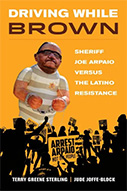Driving While Brown: Sheriff Joe Arpaio versus the Latino Resistance

Author: Terry Green Sterling and Jude Joffe-Block. 432 pages.
Publisher: University of California Press, 2021.
Reviewer: Frank R. Baumgartner | September 2022
This important, historical document tells the story of Maricopa County Sheriff Joe Arpaio’s aggressive tenure targeting the Latino community, the people who supported him, those who organized to fight his illegal policies, the legal actions that eventually brought him to justice, and the outcome of it all. Unfortunately, the book may have relevance to many communities throughout our country, particularly as politically active county sheriffs assert their independence from any institutional control. Fortunately, it provides a comprehensive, readable, and compelling explanation of how a sheriff’s department can veer into illegal activities and how marginalized communities, who are the targets of this behavior, can mobilize to stop it.
The book includes 22 chapters divided into three parts. The first part, Origins, covers the long history of struggles over immigration-rights in Arizona from 1845 to 2006. Chapters focus on the long and complicated history of workers’ rights, anti-immigrant political movements, and pro-immigrant civil rights and farm workers’ movements throughout modern history of the state. The second part, Battles, focuses on the period from 2006 to 2016. During this time, “Sheriff Joe”, a retired Drug Enforcement Agent who had been in office since winning a 1992 race against the incumbent, was at the peak of his power and influence. His agency was already known for various publicity-generating activities, such as housing residents of the county jail in tents in the desert, issuing them pink underwear, and touting himself as “America’s toughest sheriff.” Now, he was enforcing immigration law, largely using traffic stops as a way to investigate the immigration status of drivers; of course, his deputies were targeting drivers based on appearance and targeting their enforcement actions in areas where many Latinos lived or gathered. Actions were not limited to drivers with alleged traffic violations; passengers were investigated as well, and those unable to provide documentation were detained with Immigration and Customs Enforcement (ICE). Many were shaken down financially as well. The third part, Changes, focuses on the period of 2016 to 2019, in which the Sheriff was defeated at the polls and found guilty of contempt of court after refusing to comply with court orders to revise the training of his officers and to cease various illegal enforcement activities. One of the great ironies of the period, described in the book, is that Arpaio was defeated at the polls during the same election in which Donald Trump was victorious. Trump later pardoned Arpaio, ending any appeals as well as possible criminal punishments, for his contempt of court conviction.
The authors are journalists and their work is rich in detail. They are deeply enmeshed in the local community and they use several perspectives, going back and forth between bird’s eye views of the historical and sociological patterns that are obvious to any who look at Arizona’s immigration debates (but well summarized here) and up-close personal portraits of the major players. These close-ups include the Sheriff, his wife, and their supporters, as well as the most important actors in the struggle to discredit and defeat him. One gets a sense from the book of the personal motivations and social characteristics of the main characters, and not just a few of them.
This is an excellent book that shows the resilience of a marginalized community organizing and standing up for its rights. They struggle for years to build a coalition and to use the legal system to protect them from illegal enforcement actions and policies by the Sheriff’s Department. Of course, this does not come easily as many political roadblocks are in their place. Eventually, however, the legal system slowly, belatedly, and imperfectly comes to their aid. The Sheriff’s Office simply refuses to engage with the court, and the court finally reaches the end of its patience and deference to an elected law enforcement partner, declaring the Sheriff to be in contempt. That, combined with his defeat in the 2016 election, ends the protracted and controversial policies that the Office had used for so long, and which violated so many Arizonans’ rights.
But this is far from a happy story of victory for the civil rights activists. It is also a troubling story of racial and ethnic animus and a cautionary tale of the political power of hate. In a time of rising levels of identity-based politics and mobilizations based on racial and ethnic fear-mongering, this book tells an important story. It serves as the historical record of the good, the bad, and the ugly. In this case, immigrant- and minority-rights activists were (eventually) able to prevail, even while national forces were electing a new President who would take the local policies they were fighting against to new levels at the national scale. So, it is a remarkable story of resilience and victory. It also explains some more troubling elements of the political rise of Joe Arpaio; how he took advantage of fear, how he used race and othering to build a political base of power, and how once in power he flouted the US Constitution. As the authors paraphrase: “I’m the sheriff… No one tells this sheriff what to do” (p. 16).
The authors have either written the story of a failed sheriff defeated by a rising tide of community organizers seeking justice and prevailing, or they have told the story of the next elected demagogue who will use the office of the county sheriff for their own political ends, while trampling on the rights of the marginalized. No matter which it turns out to be, they have provided an important book that will be of interest to many.
Frank R. Baumgartner is a Professor of Political Science at The University of North Carolina at Chapel Hill.


